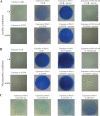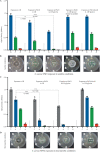Pseudomonas aeruginosa Production of Hydrogen Cyanide Leads to Airborne Control of Staphylococcus aureus Growth in Biofilm and In Vivo Lung Environments
- PMID: 36129311
- PMCID: PMC9600780
- DOI: 10.1128/mbio.02154-22
Pseudomonas aeruginosa Production of Hydrogen Cyanide Leads to Airborne Control of Staphylococcus aureus Growth in Biofilm and In Vivo Lung Environments
Abstract
Diverse bacterial volatile compounds alter bacterial stress responses and physiology, but their contribution to population dynamics in polymicrobial communities is not well known. In this study, we showed that airborne volatile hydrogen cyanide (HCN) produced by a wide range of Pseudomonas aeruginosa clinical strains leads to at-a-distance in vitro inhibition of the growth of a wide array of Staphylococcus aureus strains. We determined that low-oxygen environments not only enhance P. aeruginosa HCN production but also increase S. aureus sensitivity to HCN, which impacts P. aeruginosa-S. aureus competition in microaerobic in vitro mixed biofilms as well as in an in vitro cystic fibrosis lung sputum medium. Consistently, we demonstrated that production of HCN by P. aeruginosa controls S. aureus growth in a mouse model of airways coinfected by P. aeruginosa and S. aureus. Our study therefore demonstrates that P. aeruginosa HCN contributes to local and distant airborne competition against S. aureus and potentially other HCN-sensitive bacteria in contexts relevant to cystic fibrosis and other polymicrobial infectious diseases. IMPORTANCE Airborne volatile compounds produced by bacteria are often only considered attractive or repulsive scents, but they also directly contribute to bacterial physiology. Here, we showed that volatile hydrogen cyanide (HCN) released by a wide range of Pseudomonas aeruginosa strains controls Staphylococcus aureus growth in low-oxygen in vitro biofilms or aggregates and in vivo lung environments. These results are of pathophysiological relevance, since lungs of cystic fibrosis patients are known to present microaerobic areas and to be commonly associated with the presence of S. aureus and P. aeruginosa in polymicrobial communities. Our study therefore provides insights into how a bacterial volatile compound can contribute to the exclusion of S. aureus and other HCN-sensitive competitors from P. aeruginosa ecological niches. It opens new perspectives for the management or monitoring of P. aeruginosa infections in lower-lung airway infections and other polymicrobial disease contexts.
Keywords: Pseudomonas aeruginosa; Staphylococcus aureus; bacterial coinfection; hydrogen cyanide; volatile compounds.
Conflict of interest statement
The authors declare no conflict of interest.
Figures




Similar articles
-
Exogenous Alginate Protects Staphylococcus aureus from Killing by Pseudomonas aeruginosa.J Bacteriol. 2020 Mar 26;202(8):e00559-19. doi: 10.1128/JB.00559-19. Print 2020 Mar 26. J Bacteriol. 2020. PMID: 31792010 Free PMC article.
-
Genotypic and Phenotypic Diversity of Staphylococcus aureus Isolates from Cystic Fibrosis Patient Lung Infections and Their Interactions with Pseudomonas aeruginosa.mBio. 2020 Jun 23;11(3):e00735-20. doi: 10.1128/mBio.00735-20. mBio. 2020. PMID: 32576671 Free PMC article.
-
A Pseudomonas aeruginosa Antimicrobial Affects the Biogeography but Not Fitness of Staphylococcus aureus during Coculture.mBio. 2021 Mar 30;12(2):e00047-21. doi: 10.1128/mBio.00047-21. mBio. 2021. PMID: 33785630 Free PMC article.
-
Molecular Mechanisms of Staphylococcus and Pseudomonas Interactions in Cystic Fibrosis.Front Cell Infect Microbiol. 2022 Jan 6;11:824042. doi: 10.3389/fcimb.2021.824042. eCollection 2021. Front Cell Infect Microbiol. 2022. PMID: 35071057 Free PMC article. Review.
-
Help, hinder, hide and harm: what can we learn from the interactions between Pseudomonas aeruginosa and Staphylococcus aureus during respiratory infections?Thorax. 2019 Jul;74(7):684-692. doi: 10.1136/thoraxjnl-2018-212616. Epub 2019 Feb 18. Thorax. 2019. PMID: 30777898 Free PMC article. Review.
Cited by
-
Hypothiocyanite and host-microbe interactions.Mol Microbiol. 2023 Mar;119(3):302-311. doi: 10.1111/mmi.15025. Epub 2023 Feb 6. Mol Microbiol. 2023. PMID: 36718113 Free PMC article.
-
The New Microbiology: an international lecture course on the island of Spetses.Microlife. 2023 Mar 31;4:uqac026. doi: 10.1093/femsml/uqac026. eCollection 2023. Microlife. 2023. PMID: 37251515 Free PMC article.
-
Multi-omics analysis elucidates the host-microbiome interplay in severe udder cleft dermatitis lesions in dairy cows.JDS Commun. 2024 Mar 29;5(6):598-601. doi: 10.3168/jdsc.2023-0537. eCollection 2024 Nov. JDS Commun. 2024. PMID: 39650020 Free PMC article.
-
Dual-function regulator MexL as a target to control phenazines production and pathogenesis of Pseudomonas aeruginosa.Nat Commun. 2025 Feb 26;16(1):2000. doi: 10.1038/s41467-025-57294-8. Nat Commun. 2025. PMID: 40011517 Free PMC article.
-
Innovative nebulization delivery of lipid nanoparticle-encapsulated siRNA: a therapeutic advance for Staphylococcus aureus-induced pneumonia.J Transl Med. 2024 Oct 15;22(1):942. doi: 10.1186/s12967-024-05711-9. J Transl Med. 2024. PMID: 39407291 Free PMC article.
References
-
- Kesarwani M, Hazan R, He J, Que Y-A, Que Y, Apidianakis Y, Lesic B, Xiao G, Dekimpe V, Milot S, Deziel E, Lépine F, Rahme LG. 2011. A quorum sensing regulated small volatile molecule reduces acute virulence and promotes chronic infection phenotypes. PLoS Pathog 7:e1002192. doi:10.1371/journal.ppat.1002192. - DOI - PMC - PubMed
Publication types
MeSH terms
Substances
LinkOut - more resources
Full Text Sources
Medical
Molecular Biology Databases

